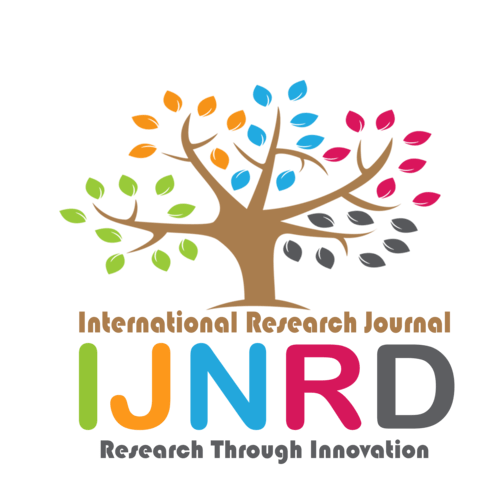|
|||||||||||||||

|
INTERNATIONAL JOURNAL OF NOVEL RESEARCH AND DEVELOPMENT International Peer Reviewed & Refereed Journals, Open Access Journal ISSN Approved Journal No: 2456-4184 | Impact factor: 8.76 | ESTD Year: 2016 Scholarly open access journals, Peer-reviewed, and Refereed Journals, Impact factor 8.76 (Calculate by google scholar and Semantic Scholar | AI-Powered Research Tool) , Multidisciplinary, Monthly, Indexing in all major database & Metadata, Citation Generator, Digital Object Identifier(DOI) |
||||||||||||||
Issue: May 2024
Volume 9 | Issue 5
Review Result and Publication of Paper within : 2-3 days
Click Here For more DetailsFor Authors
Forms / Download
Published Issue Details
Editorial Board
Other IMP Links
Facts & Figure
Impact Factor : 8.76
Issue per Year : 12
Volume Published : 9
Issue Published : 96
Article Submitted :
Article Published :
Total Authors :
Total Reviewer :
Total Countries :
Indexing Partner
Join RMS/Earn 300
Licence
This work is licensed under a Creative Commons Attribution-NonCommercial 4.0 International License







|
Published Paper Details
|
|
| Paper Title: | DRIVER DROWSINESS DETECTION |
| Authors Name: | Udhayakumar M , Sudhakaran R , Nishanth M , Priya V , Tharun T |
| Download E-Certificate: | Download |
| Author Reg. ID: |
IJNRD_218954
|
| Published Paper Id: | IJNRD2404620 |
| Published In: | Volume 9 Issue 4, April-2024 |
| DOI: | |
| Abstract: | Driver drowsiness is a significant factor contributing to road accidents worldwide. To mitigate the risks associated with drowsy driving, various techniques and technologies have been developed for early detection and alerting of drowsy drivers. This paper presents a comprehensive review of existing methodologies and advancements in driver drowsiness detection systems. The review encompasses traditional approaches such as monitoring physiological signals including eye movements, heart rate variability, and EEG signals, as well as modern techniques leveraging computer vision, machine learning, and sensor fusion methods. We examine the strengths and limitations of each approach, highlighting their effectiveness in real-world scenarios. Furthermore, we discuss the challenges associated with drowsiness detection systems, including variability in individual drowsiness patterns, environmental factors, and system robustness. Insights into emerging trends such as deep learning, wearable sensors, and in-vehicle monitoring systems are also provided. By synthesizing the current state-of-the-art, this review aims to provide researchers and practitioners with a comprehensive understanding of driver drowsiness detection techniques, fostering the development of more reliable and effective systems to enhance road safety. Physiological Signals Monitoring: This technique involves monitoring various physiological signals such as eye movements (blink rate, eyelid closure duration), heart rate variability (HRV), and electroencephalogram (EEG) signals to assess the driver's drowsiness level. Changes in these signals can indicate fatigue and drowsiness.Computer Vision: Computer vision-based systems analyze facial features and driver behavior captured by in-vehicle cameras to detect signs of drowsiness, such as drooping eyelids, yawning, and head nodding. Advanced algorithms can accurately identify these cues even under varying lighting conditions and facial orientations. Machine Learning: Machine learning algorithms, particularly classifiers such as support vector machines (SVM), random forests, and deep neural networks, are used to process data from physiological sensors or computer vision systems and classify the driver's drowsiness level based on learned patterns and features. Sensor Fusion: Sensor fusion techniques integrate data from multiple sources, such as physiological sensors, cameras, steering wheel sensors, and vehicle movement sensors, to enhance the accuracy and reliability of drowsiness detection systems. By combining information from different modalities, these systems can provide more robust assessments of driver alertness. Real-Time Alerting: Drowsiness detection systems typically incorporate real-time alerting mechanisms to warn drivers when signs of drowsiness are detected. Alerts can be auditory, visual (e.g., flashing lights or warnings on the dashboard), or haptic (e.g., seat vibrations), aiming to prompt the driver to take corrective action, such as pulling over for a rest or taking a break. |
| Keywords: | Drowsiness Detection, DriverFatigue, Eye Tracking, Facial Recognition, EEG Signals, Machine Learning, Artificial Intelligence, In Vehicle Monitoring, Wearable Sensor, Reaction Time, Departure Detection. |
| Cite Article: | "DRIVER DROWSINESS DETECTION", International Journal of Novel Research and Development (www.ijnrd.org), ISSN:2456-4184, Vol.9, Issue 4, page no.g191-g196, April-2024, Available :http://www.ijnrd.org/papers/IJNRD2404620.pdf |
| Downloads: | 00032 |
| ISSN: |
2456-4184 | IMPACT FACTOR: 8.76 Calculated By Google Scholar| ESTD YEAR: 2016 An International Scholarly Open Access Journal, Peer-Reviewed, Refereed Journal Impact Factor 8.76 Calculate by Google Scholar and Semantic Scholar | AI-Powered Research Tool, Multidisciplinary, Monthly, Multilanguage Journal Indexing in All Major Database & Metadata, Citation Generator |
| Publication Details: |
Published Paper ID:IJNRD2404620 Registration ID: 218954 Published In: Volume 9 Issue 4, April-2024 DOI (Digital Object Identifier): Page No: g191-g196 Country: Krishnagiri, Tamil Nadu, India Research Area: Science & Technology Publisher : IJ Publication Published Paper URL : https://www.ijnrd.org/viewpaperforall?paper=IJNRD2404620 Published Paper PDF: https://www.ijnrd.org/papers/IJNRD2404620 |
| Share Article: | |
|
Click Here to Download This Article |
|
| Article Preview | |
|
|
|
Major Indexing from www.ijnrd.org
| Semantic Scholar | Microsaoft Academic | ORCID | Zenodo |
| Google Scholar | ResearcherID Thomson Reuters | Mendeley : reference manager | Academia.edu |
| arXiv.org : cornell university library | Research Gate | CiteSeerX | PUBLON |
| DRJI | SSRN | Scribd | DocStoc |
ISSN Details
 |
 |
ISSN: 2456-4184
Impact Factor: 8.76 and ISSN APPROVED
Journal Starting Year (ESTD) : 2016
DOI (A digital object identifier)
Conference
Open Access License Policy
Important Details
Social Media
| Copyright © 2024 - All Rights Reserved - IJNRD |












Facebook Twitter Instagram LinkedIn